|
Imagine 100 exceptionally skilled and ambitious male and female professional golfers from around the globe fresh from successfully graduating tour school and starting out on their first year on tour. Now if I asked you how many of them you think would still be competing on tour 10 years from today what would your answer be?... I asked one of our professional tour clients Steven Jeffress (on tour for 15 years) who plays on the Japan Tour his estimation of the percentage of golfers that would still be playing on tour in 10 years and he said without hesitation that "90 to 95 percent of those 100 golfers would not be playing on tour in 10 years." "90 to 95 percent of those 100 golfers would not be playing on tour in 10 years!" And you know what? He’s right; most of those exceptionally skilled male and female golfers will have given up on their dream of becoming a successful tour player well before their 10 year mark on tour. Why is this the case? Here are some of the reasons. For the majority of them they realize that the grind of tour life (travelling, away from home, the financial investment) is not for them and they decide to settle down, find a steady job and possibly start a family. Others simply don’t play well enough to stay on tour as they soon discover that it costs a lot of money to pursue their career choice and because they don’t perform consistently well enough on tour they run out of funds enough times that eventually they go and do something that's less stressful. Still another percentage of the 100 will stick at it for a while longer making enough checks to get by, but never really breaking through to earn the big checks that will change their life. Eventually they also give up because they start to believe that they don't have what it takes anymore to make it on tour. And then finally there’s the few who stay on tour and realize their dream of playing successfully on a pro tour and are reaping the rewards of their commitment to the journey. 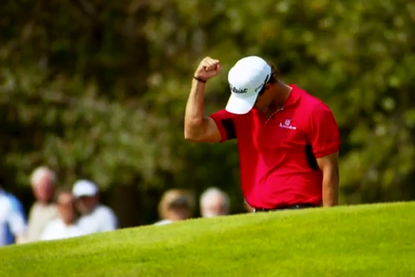 Building Competitive Advantage So how do this last group of the 100 do it? They do it by building competitive advantage into their game that allows them to become a competitive force on tour. The following quote is the most accurate description I have found that aptly describes competitive advantage for golfers on a professional golf tour. “The term competitive advantage is the ability gained through attributes and resources to perform at a higher level than others in the same industry or market.” With so many professional golfers never realizing their dream of a successful life on tour, and who never reap the benefits of their hard work and commitment, this quote is very helpful and insightful for those that are on tour now, or are contemplating it. So let's look at it a little closer at what it means. Basically this quote describes the two essential elements in the formula - attributes and resources which are the elements you need to help you to build competitive advantage in your game. What Attributes and Resources Do You Need? In our last article I described the 4 key mental attributes that keep you playing golf on tour for the long-term, and if you are to build sustainable competitive advantage for the tour you will need the resources to be able to identify, isolate and improve the golf skills and routines that increase your ability to produce a low golf score average over a season. With about 156 golfers in the field each week competing for the prize money on offer, golfers who have developed a sustainable competitive advantage on their respective professional tour are those that primarily do 2 things really well;
Many Ways to Learn But Fewer Ways to Earn We want you to understand that your primary goal for each season is to develop your competitive advantage by making more cuts over a season than less with a steady style game. Every bit of effort you invest into your game both on and off the tour is to achieve this end because the golfers who have been able to stay on tour the longest are the same golfers who year-in-and-year-out make the highest percentage of cuts. About 45 percent of the field each week (about 70 golfers plus ties) will make the cut each week and out of the 70 or so golfers who play day 3 and 4, those that finish in the top 20 percent of the field will earn most of the prize money available for that tournament. Once you get outside of the top 15 to 20 golfers the prize money thins out dramatically. So the big question to ask yourself is "what are the resources that would help me to lower my tournament score average - particularly on day 1 and 2 so I can make more cuts over a season and earn more income?" In-fact it’s the only question that you should continually ask yourself if you want to develop a sustainable competitive advantage on a professional golf tour. 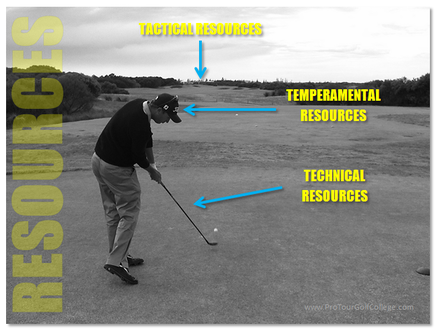 So What Exactly is a Resource? A resource in the context of golf improvement and sustainable competitive advantage is any technology, methodology or strategy that you use to influence your skills to meet your goals. Simply put, it is a vehicle for driving your golf scores down and keeping them there. The three primary resources (we call 'T' resources) that will influence improvement in your golf skills and performances on the golf course are:
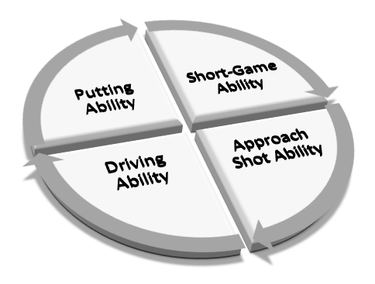 Your Weakest-Most Important Skills (W.M.I.S) Ranking Procedure You need to sit down with your golf instructor, coach or caddy to carefully evaluate your performances on the golf course in the 4 primary performance categories.
You need to determine your current standards in these 4 basic areas of the game to start with before you decide which specific resources you will need to positively influence your performances on the golf course. The resources you ultimately choose will help you to make more cuts than you miss, and make more money than you spend. Step 1. Your first task is to download our W.M.I.S Golf Skill Assessment sheet (below) so you can identify and isolate your weakest-most important golf performance category (that houses the sub-category of golf skills) that keeps your tournament score average high, making it harder for you to make the cuts in tournaments.
The 4 Primary Performance Categories Are: 1. Shots played on the greens (Your putting ability) 2. Shots played within 90 metres or 100 yards of the green (Your short-game ability) 3. Approach shots into the green from outside 90 metres or 100 yards (Your shot-making ability) 4. Tee shots (Your driving ability) So let's start and like I said with the help of your instructor or someone who is very familiar with your game like a caddy give yourself an honest and realistic grading by circling A, B, C or D on your assessment sheet in each of the 4 primary golf performance categories of putting skills, short-game skills, approach shot skills and driving skills which have been broken up into the 3 primary resources of technical competence, tactical competence and temperamental competence: The 3 Primary Resources Are:
Each grade A, B, C or D also has a numerical value associated with it that relates specifically to your knowledge of how to execute the skills within the category, and also your ability to execute these skills under pressure. Step 2. So give yourself an honest and realistic rating based on the following: A = 75 to 100 percent (Very knowledgeable in it and can perform it anytime under pressure) B = 50 to 75 percent (Somewhat knowledgeable and can perform it most of the time under pressure) C = 25 to 50 percent (Lack knowledge in it and mostly fail to perform it under pressure) D = 0 to 25 percent (No knowledge in it and can't perform it under any pressure) Now that you have identified the weakest to strongest golf performance primary categories you will need to rank them from your weakest - most important golf performance category to your strongest. Place a number from 1 to 4 under the primary performance category that when this category is improved it will have the most positive effect on improving your golf score average in tournaments. The thing to understand here is that your techniques, tactics and temperament are inextricably linked in the golf performance equation and being weak in any one area will have an influence on another. Once you have completed the first part of the assessment it will look similar to ours and you will have completed the first step in identifying and isolating the primary performance categories that house the skills that are keeping you from building sustainable competitive advantage on tour. Now within these 4 primary performance categories are the sub skill categories that house the specific skills like putts made from 5 feet, or proximity to the hole from 65 yards etc. that you must constantly track, test, measure and manage to determine specifically where you should aim your focus and energy to upgrade them.
"You see to become a top class golfer you will need to develop a very high stress tolerance threshold to deal with the continual adversity that is fundamental to the way the game of golf is played. It's a game that cannot be perfected, what part of that don't you understand?" What kind of attitude would you need to have to be one of the best in a sport where for at least 90 percent of the time your outcomes are nowhere near your expectations, and every-time you competed you spent five or more hours at the venue - but only executed skills for about 3 to 4 minutes out of the 5 or so hours? I want you to really think about your answer/s to this question for a moment, and then answer it... Did your answer/s to this question bear a resemblance to any of the ones below?
So did you get any of these? If you did, well done, and if your answers were similar to the one's above then you would be pretty close to the mark, and of course the sport I am describing is the game of golf. The game we can love and hate almost at the same time. Of all the sports you can play, this is the one that relies heavily on sound thinking skills, excellent emotional management, a sharp decision making ability, and a laser focus to be really good at it. Where do you learn to develop these attributes? Certainly not at any mainstream school or college. Imagine that you never knew that you needed some or all of these attributes, do you think it would make a difference to how good you could get playing golf? I'm sure it would. It is interesting when you look at the list that there is no mention of skills in the answers? Obviously the traits highlighted within these answers will have a huge effect on your skill execution. Now just for a moment imagine that you didn’t have this type of attitude; do you think you could get to the heights of the game of golf? Take the Test Take our simple little test now and find out where you sit, and discover whether your attitude needs an adjustment that is currently holding you back from playing much better golf. I think you will agree that you will enjoy golf more, and also get a lot more out of your game if you sit on the right hand side of the line?
After many years of observing golfers working and competing we have noticed over and over a small amount of consistent traits or behaviors that are consistent with the golfers who keep finding ways to play better and eventually get to the top of amateur and professional golf, versus those that struggle with/and give up much earlier than they should. The 4 Core Mental Traits We call these The 4 Core Mental Traits and they describe the 4 rock-solid core traits that we continually identify in golfers who perform better and more consistently over the long term than their fellow competitors. There are other important traits that you could add to these, but in our experience these are the 4 core traits that drive long-term performance improvement. These traits describe qualities that you should continually strive to develop in your golf career whether you are an amateur or professional, and they will enhance your performance process and keep you focused on achieving your most important goals on the golf course. 1. Perseverance You will fail many more times than you succeed in your attempts to win golf tournaments and as a case in point I saw recently where Kenny Perry discussed this point with an interviewer and mentioned that he had played about 660 tournaments on the PGA Tour and 'only' won 14 times. Think of how many holes and golf shots Kenny Perry hit to win 14 times in his career on the PGA Tour? So let's do a few basic sums and work out roughly what it would be. Let's say that Kenny Perry made 65 percent of the cuts in those 660 tournaments (429 tournaments x 72 holes) he would played 30,228 holes in PGA Tour events over his career. Now imagine how many golf shots that equates to? I think you can see that Kenny Perry hit more than one hundred thousand golf shots in PGA tournaments over his 30 year career to win 14 events. You need to truly understand that you will fail many more times than you succeed and simply acknowledge that this is a simple fact of life in high performance golf and the more you can live with this truth and just get on with playing the game the better. Golfers who are willing to persist with their effort to succeed for longer will have much more success in golf than those that don’t. You will literally hit hundreds of thousands of golf shots in your golf career and most of them will be far from perfect, and it will be your determination to keep striving for improvement when you face continuous adversity that will keep you on the success track. You must develop a deeply embedded belief that every setback you face is just feedback and not failure, and that it simply reminds you that to be a great golfer you will have to have more determination and persistence than the next golfer. Your Key Success Strategy - "I Never Give In and Never Give Up" 2. Perspective You need a long-term outlook of where you will take your game to if you want to achieve any level of success in golf. Justin Rose was a professional golfer for 15 years before he won the US Open, and Adam Scott was on tour for 14 years before he won the US Masters. It is very hard to persist with golf with a short-term perspective because if you think about it, how can you have a long-term career in golf with a short-term perspective? You can certainly have short-term goals but ideally they will fit into your long-term plan. For more on developing a long-term golf plan check this out (click here) Perspective enhances patience, poise or self-control in your game and is essential for learning how to accept the mistakes that you will inevitably make in every round you play. Notice that all the great players have poise under pressure? It's because they have perspective, that is, they can see a bigger future than a few shots that didn't come off the way they expected in a round of golf. It’s a long-term perspective or vision of your golfing future that can help you to see past the normal day to day set-backs that can and do slow down the progress of golfers. Perspective keep you moving forwards towards your vision of where you want to take your game ultimately to. Your Key Success Strategy - "Small Set-backs Won't Change My Destination" 3. Positiveness You will never be able to play this game with perspective and also positiveness - a key driver of motivation that helps you to keep getting up from the canvas smiling when you suffer continual knockdowns or set-backs. Positiveness basically describes your day to day outlook and heavily influences the type of energy you invest into your game. Positive energy helps you to keep finding ways to improve your game because it essentially allows you to keep seeing a bright, successful future. Because golf is such a challenging game it is easy to see the dark side of things, but you need to be a lot bigger than your bad moments and keep seeing the positive side of things. Positiveness helps you to manage stress and also enhances your perception positively of what's possible because it helps you to focus on the good in your efforts rather than the bad. And when you look at your career positively you can see that your success in golf is about being bright in the dark moments, and this alone makes it easier to get up, dust yourself off and keep turning up to play your best. Your Key Success Strategy - "The More Up I Am, The Lower I Can Go" 4. Pluck Pluck is an unusual word that basically describes spirited and determined courage, and if someone tells you that you have pluck then you are receiving a huge compliment. To us pluck describes a golfers courage to stay creative and not become technical and overly mechanical - particularly when they have hit a few poor shots and are faced with a challenging shot at a crucial time in a round. And this is one of the biggest challenges you will face as you get better. You have to learn to let go of the mechanical, and learn to embrace the creative. We think it takes a lot courage to keep finding ways to play better without reacting to poor golf shots and sending yourself back to the classroom for more theory and technique change. Tiger Woods has shown us all how much pluck he has, and over his career he has been able to compete even when his technical skills were not at their best, and he still has the courage to play creatively. To become a great golfer you have to be creative and adaptable in the environment you are competing in, and because your plans doesn't always come off you need to be able to do as the US Marine Core are trained to do and improvise, adapt and overcome the challenge of the moment, sometimes with gutsy shots that you wouldn't normally play. Sometimes safe is not an option, and the great players have all proven that when "the chips are down" they are often at their best and will hit clutch shots that get them back into the game and onto the scoreboard. Your Key Success Strategy - "I Can Play the Shot That's Needed Now" The key point to learn here is that golf is not a game that you can perfect, so stop trying to play this game that way? It is a game of "less than perfect shots" and needs to be learned and developed with that in mind.
How This Simple 4 Step Secret Formula Will Take You From Amateur Golfer to Successful Tour Golfer12/4/2014
“In the 'Many Worlds Interpretation of Quantum Mechanics,' the trajectory of your life is no longer just one straight path to an eventuality, but is instead one path of many, on an ever-branching tree of possibilities.” 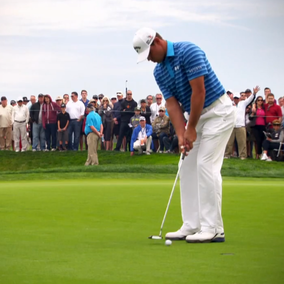 It’s no surprise that many amateur golfers want to become professional golfers today. And who can blame them for thinking this way? After all, when they see golfers on the TV earning big dollars in pro tournaments, not to mention the sponsorship dollars using a big brand sponsors equipment, like I said; who could blame an amateur golfer for thinking this way? Virtually every tour player was a junior golfer playing at a golf club somewhere, and at some point of time they were exposed to the idea of playing professional golf, and this lead them on the pathway to becoming a professional golfer. In my case this is pretty much how it occurred (although I’m not sure how I was exposed to the idea initially) although I can vividly recall as an 11 year old that the walls surrounding my bed were plastered with poster images of successful tournament players and every night I went to bed seeing those images before I closed my eyes. I'm sure that this helped a lot. At school all I thought about was playing and practicing golf to get better at it so I could become a professional golfer one day. What started off as a day to day dedication to that idea, eventually became a reality for me. It took me about 10 years from the time I began playing golf until the stage when I had completed my PGA apprenticeship and could go and try to qualify to play golf on a professional tour. Earl Nightingale in his famous recording “The Strangest Secret” was right when he shared that the secret was that “you become what you think about all day long”…And I would humbly add to that, "what you work on all day long" as well. 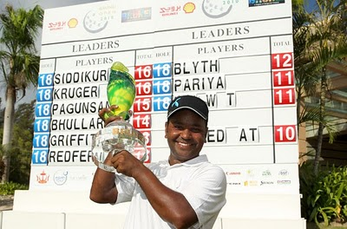 Siddikur Rahman is a successful professional golfer from Bangladesh Siddikur Rahman is a successful professional golfer from Bangladesh Believe it First Then You Will See it Here’s the important thing to understand; it doesn’t matter where you come from, or what family you were born into; if you want to play golf good enough to play on tour one day, then you have to start by believing its possible first. Successful professional golfers have come from the most unlikely places around the world and have found a way to get to the pro tour and become successful. Take a good look on the Asian Tour or the European Tour and just have a look at the many different countries that have professional golfers representing them. Years ago just a few nations produced all the golfers playing on professional golf tours, but today they come from every corner of the globe. So start believing that its possible, and tell yourself continually, and truly believe what you tell yourself. Then with this daily verbal dedication to the idea combine it with lots of the right type of skills practice, golf course practice and tournament play and you'll be on your way. Now this approach will not be popular with those that have grown up with a belief that it takes a lot more than telling yourself that it’s possible and thinking about it continually. Yes I agree that it does take a lot more than talking and thinking about it all the time, but it always starts there. Without an idea to work with what have you got? Everything worthwhile began with an idea right? Some people believe that you need “talent” more than anything else, and as much as I can respect their beliefs, I don’t agree with them. Not one little bit. “Talent” doesn’t cut it anymore; you will severely limit your potential for success if you buy into this limiting belief. What it always takes is a special kind of hard work, coupled with great information that you may not possess as yet, and an unnatural desire to achieve your goal whilst continually pushing against massive resistance. And believe me you will face a lot of resistance along the way. I mean how can you not, when what you are attempting to do is far from normal? "What this power is, I cannot say. All I know is that it exists...and it becomes available only when you are in that state of mind in which you know exactly what you want...and are fully determined not to quit until you get it." – Alexander Graham Bell
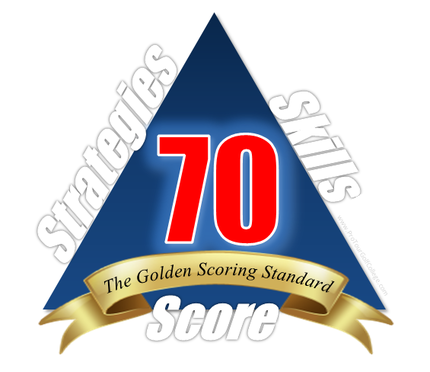 The Golden Scoring Standard The key to your success at playing golf on a professional golf tour is by reaching the golden scoring standard which guarantees that you can qualify, compete and earn a lot more income than you spend competing on a professional golf tour. The golden scoring standard in men's and women's professional golf is a score average of 70, and this score average will give you all the success in golf you can imagine. Many reading this will understand this because they were on the pro tour path and are no longer on it because they didn't achieve the golden scoring standard in the time they allowed themselves to achieve it. Or maybe they simply didn’t know what the golden scoring standard was, and had they known, they might have kept working towards it? The Golden Scoring Standard Success Formula The way we share it with golfers in our program at Pro Tour Golf College (who all want to play golf successfully on a professional tour) is that their ultimate goal is to aim for and achieve the golden scoring standard. The way to get to this golden scoring standard is with a whole set of well trained skills that have been influenced by well thought out and relevant improvement strategies that move you continually towards the pro tour score standard. What is the glue that strengthens the link between this set of skills and the golden scoring standard? It's this simple formula... What is Sweat Equity? Sweat equity is your daily physical investment in this success formula; the amount of and the quality of hard work (practice) you put into your game every single day. Your ability to achieve this golden scoring standard will be influenced primarily by the strategies you employ, along with the way those strategies influence the improvement in your golf skills, and how hard you work to develop them to the very high standard that's required. The Golden Standard Success Sequence... Work on the right skills for long enough and you will move continually along the pathway towards the golden scoring standard. Work on the wrong skills and no matter how hard you work you won’t achieve your goal. This is a formula for golf success and we want you to think about it as if it was a code that opened a lock to success. If you remove any part of the formula it won't work. You need...
Seek out suitably qualified teachers, coaches and mentors who can help you to create the best strategies to guide you along your path towards the golden scoring standard. And like I said earlier, you are likely to face a lot of resistance along the way, but be positive, embrace it, and look beyond it, so you just keep moving forwards ever closer to the golden scoring standard.
How to Practice Golf: The Golf Swing Change Model That Will Help You To Play Better in Less Time5/4/2014
If you are a regular reader of our articles then you know that we freely share our thoughts, experience and our methods with you on how you can improve the way you practice and play golf so that you can achieve your golfing goals faster. David and I are in a fortunate position that we have been helping golfers of all ability levels day-in-and and-day-out for well over 20 years. When you spend this much time helping golfers to improve you start to notice consistent patterns in the way they go about trying to improve their game. Some of these patterns are helpful, but too often they are nothing more than a much longer way to achieve their goal. Strangely some golfers can find a way to take something that’s relatively simple to understand and do, and make it a lot more complicated. We often ask ourselves; "why do some golfers make this complicated game even more complicated?" Confusion reigns supreme in golf...still! We also find as golf instructors that the more time we spend searching for ways to improve our students the more we realize that it’s often just one simple principle applied thoughtfully and deliberately that seems to have the most influence on improved performance on the golf course. 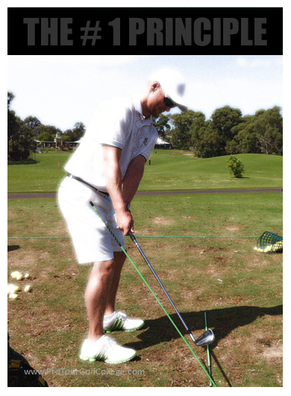 The # 1 Golf Swing Change Principle Today more than ever there are so many options for you to improve your golf from experts from many different fields like; psychology, bio-mechanics, sports medicine and equipment technology and the practitioners from these domains all want to share their knowledge and experience with you, and help you to play better. But we continually find that regardless of the approach used, and who is teaching it, the key principle that has helped our golfers the most over many years of teaching is this one: Reduce the complexity and increase your competency The lure of the fast-track to golf success is ever present, and you need to realize that your ultimate success in golf is going to get down to whether you can stay focused on this key principle by reducing the distraction of trying to do too many things perfectly, rather than focusing on improving your weakest-most important golf skills; These are the high pay-off skills that drive performance up, and golf scores down. This simple principle say’s that the more complexity you introduce into your game, the more mistakes you will make, and the more mistakes you make, the longer it will take you to reach your golf goals. So how do you manage complexity in your golf game? 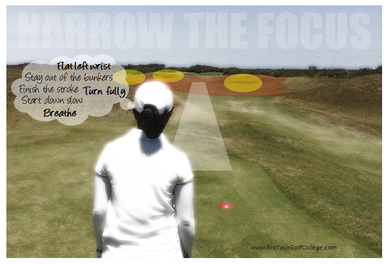 Click on the image to make it larger Click on the image to make it larger What is Golf Complexity? Complexity as it relates to golf improvement is the amount of elements that you are focusing on and managing as you swing the golf club, in order to achieve a particular goal. For example; imagine that you are standing behind your golf ball and preparing to walk into the ball to hit your shot. The timeline for your pre-shot routine is likely to be between 10 and 20 seconds from the walk in to the finish of your stroke. The key to successfully executing the stroke will get down to how few things you are able to think about prior to pulling the trigger. That's not so easy to do right? That’s right, it’s not easy to do because you are required to reduce all the “how to” thoughts you have down to one clear image and/or feel of what you want to do with the shot, and then execute it. Now if you have been working on complex swing changes, then this will make it really challenging for you because your mind has been exercising and making a habit of processing quite a few chunks of information.  One thought and one swing One thought and one swing Compounding Complexity Imagine that you are working on your golf swing with your instructor and your goal is to change your stroke pattern so that you can hit more effective shots under pressure. The key question here is how many elements within your stroke pattern can you think about and perform competently? My guess is not too many. In-fact, I doubt that you could think of two factors at the same time and execute your golf stroke without making a mistake. Now mistakes are a normal part of the pathway to mastery, however, the idea is to reduce the mistakes by employing simple methods that improve the way you strike the ball under pressure. We have found that the best way to do this is to reduce the amount of influencing factors (the complexity) in the method you use. The method is the practice drill, training aid or practice routine that takes the idea of change and turns it into reality. Remember that your goal should always be to increase skill competency by decreasing skill complexity. You should break your skill down into a smaller amount of information chunks that you completely understand, and then develop one part or chunk at a time. 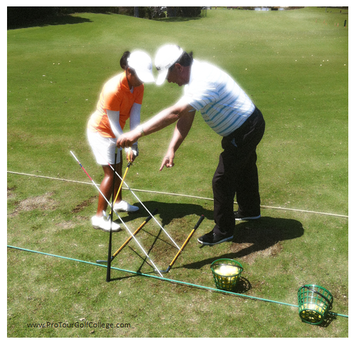 Break the process down into smaller chunks Break the process down into smaller chunks Expediency is Your Enemy We know as golf instructors that you want to improve faster, but you can’t speed up the biological learning process unless you can simplify your approach to learning each part of the stroke pattern carefully and deliberately. The best you can hope for is that your golf instructor can design highly specific and relevant training drills and techniques that get to the core of your swing change, and that you apply them continually in an environment away from distraction. But even this is not enough. You need to have these chunks of information communicated to you in such a way that the outcome is that you learn each part correctly. If you don’t truly understand what you are trying to do, then you will surely have problems further down the road. If you don’t understand the process of change you are attempting to make, then it is likely to be more complex than it needs to be. Work with your instructor to make it simpler and easier to understand. Break the skill process down further and focus on the first change component. 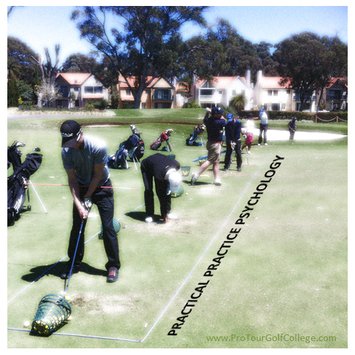 Practical Practice Psychology So how can you practice your golf skills to accelerate change? The key is to realize that what you are fundamentally doing is changing behavior. The only way we know to accelerate swing change behavior is to start by reducing the major distractions in learning and improving golf, and the major distraction that tops the list is focusing on the target when you shouldn't be. That’s right, focusing on trying to hit perfect golf shots to a target whilst managing multiple swing thoughts is highly complex, and a guaranteed recipe for disaster. It's also the slow track to golf swing change. Ideally you should start with a swing change model like ours (below) that gets you to ask the important questions about what you need to do, and how long you will need to do it for, to create a new habit. Changing a golf stroke pattern successfully requires that you do these four things; 1. Allocate time each day to perform the stroke change process 2. Receive the information relating to the change component so that you understand it completely 3. Perform with pre-designed relevant drills, aids and routines performed with the correct amount of stroke volume 4. Determine the timeline when your practice goes from a technique focus to a target focus It’s essential that you understand that by increasing the number of components that you attempt to change within your golf stroke the more complex it becomes. More components equals a higher amount of mistakes, and with a higher amount of mistakes, the longer it will take you to change the stroke pattern.
If you are working on golf swing changes with your instructor make sure that you use our simple golf swing change chart as a guide to help you change your stroke successfully.
Pro Tour Golf College is Opening in Indonesia in 2014
We will be opening our National Golf Training Centre at Emeralda Golf Course in July and inviting serious amateur and professional golfers aged 10 to 30 to train part time and full-time in our world class programs. For expressions of interest please contact us at [email protected] |
Archives
June 2019
|
||||||||||||||||||||||||
Proudly Supported By
Copyright © 2011 - 2018 Pro Tour Golf College
Website Managed By Golf Performance Media
All Rights Reserved
Website Managed By Golf Performance Media
All Rights Reserved




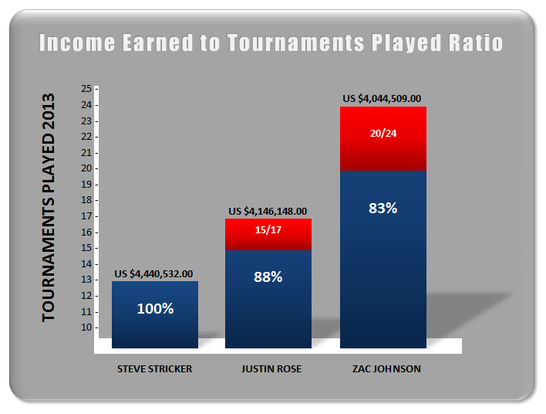


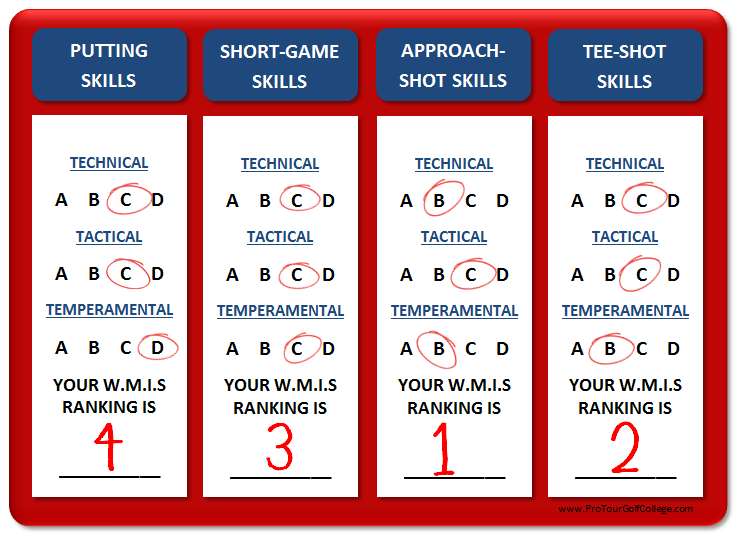


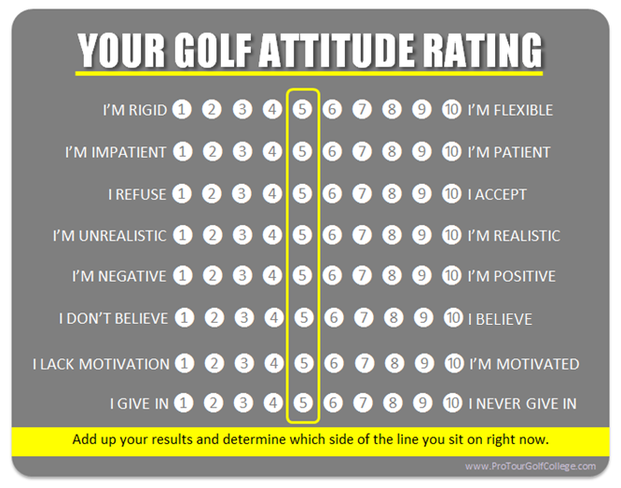

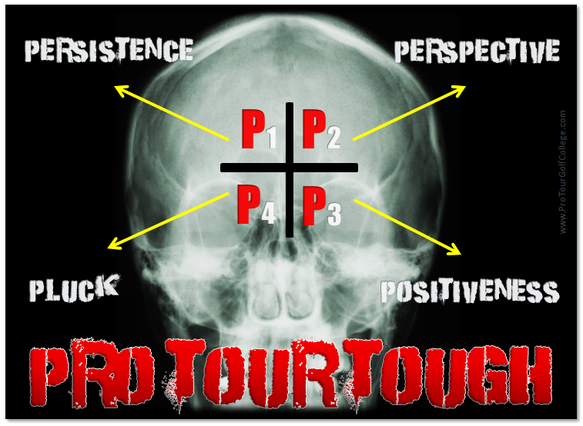
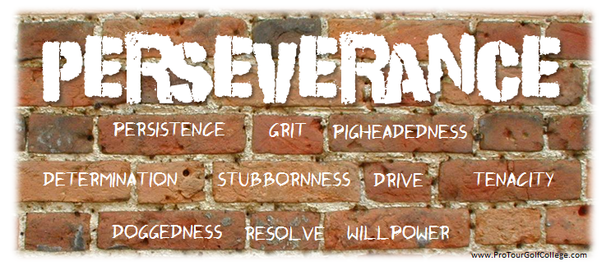
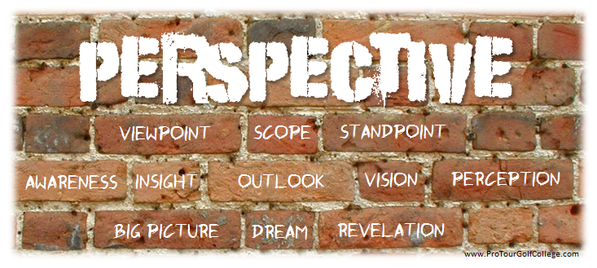
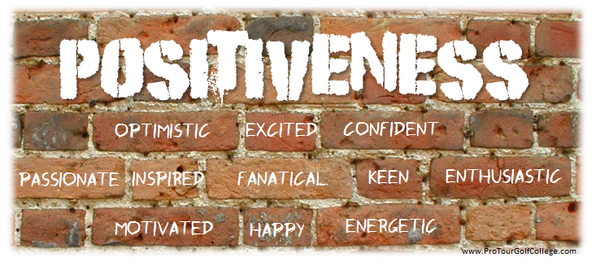
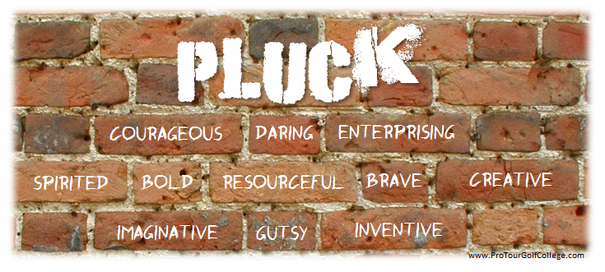


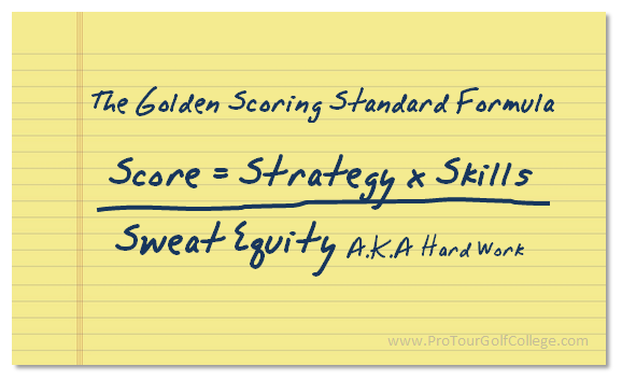
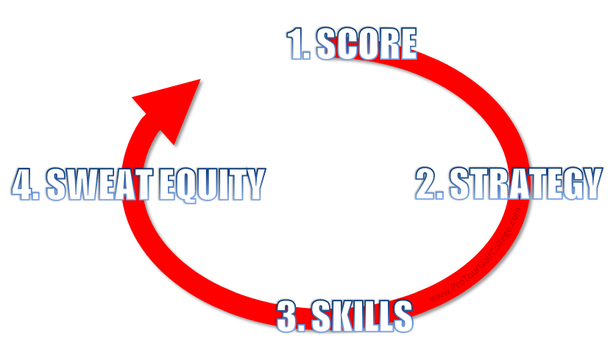

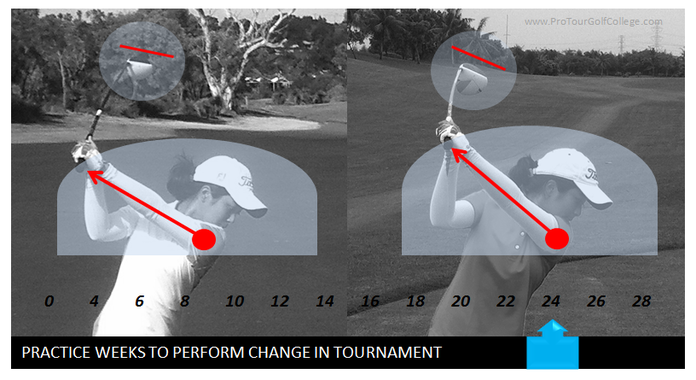

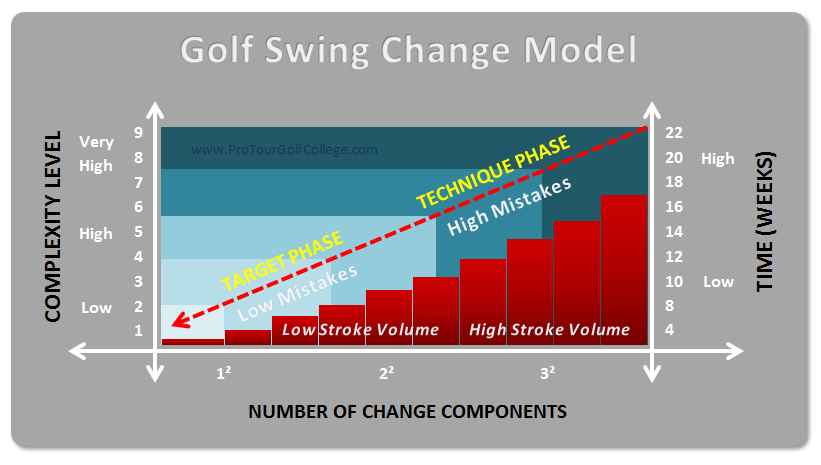


 RSS Feed
RSS Feed



